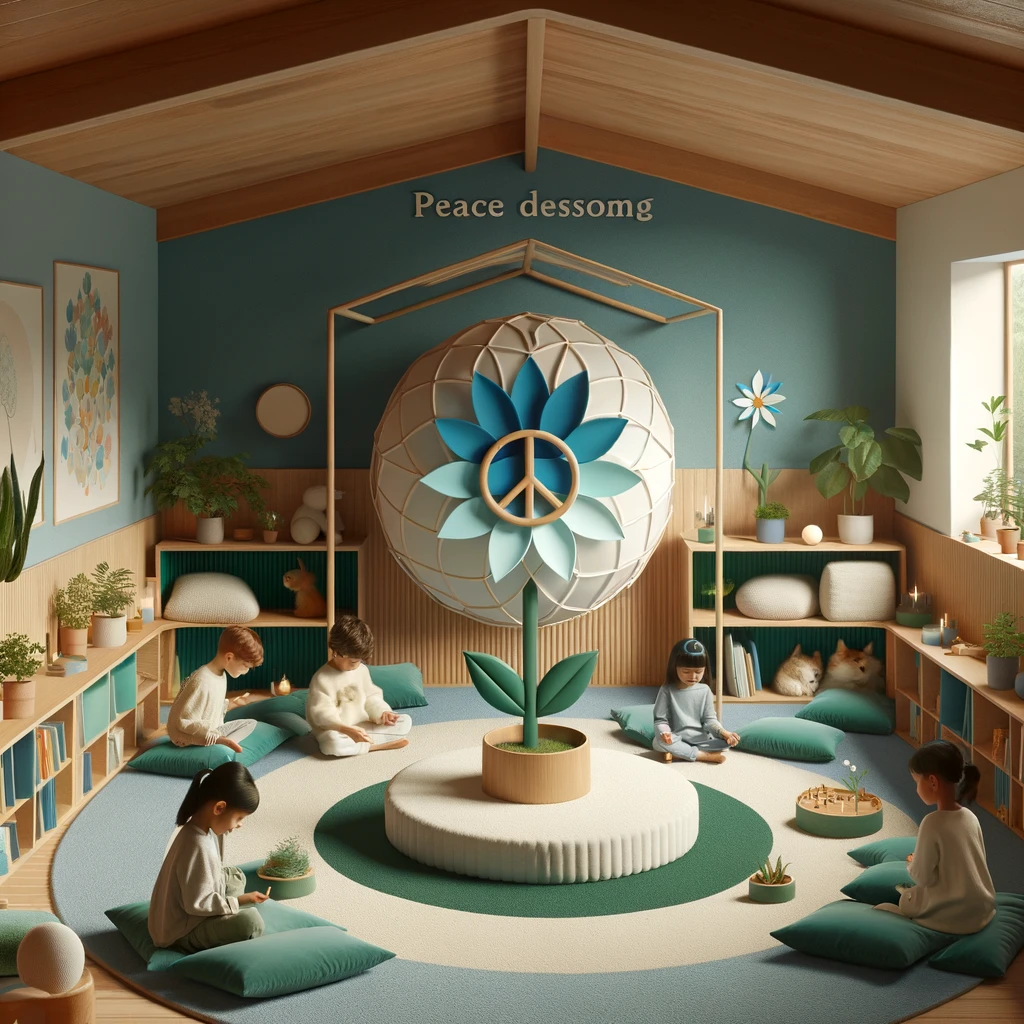All Montessori Peace Flower activities have been scientifically designed by Dr. Maria Montessori according to the inner strong needs of the children. The fulfillment of inner self in an environment, where children work with concentration, freedom and self- confidence result in normalization.
The Impact of Normalization on Child Development in Montessori Education
Montessori Peace Flower In the state of normalization, the children are happy, calm and enthusiastic about their studies. Furthermore, a normalized child requires only a little direction to work, and he does not disturb others or damage the environment.
He also treats others and the environment with respect, and works quietly on his own or in a group. One of the key aims of the Montessori method is to normalize the child. A normalized child displays joy, calm, responsibility and serenity in what he does.
The whole process of achieving normalization helps develop self-awareness also. As discussed already, young children learn to be aware of themselves through their involvement in meaningful activities, which happens gradually with time in the presence of a suitable physical environment, and appropriate modeling by teachers and their adults.
Improper nutrition also adversely affects the development of self-awareness. A hungry person or a person suffering from malnutrition cannot have a peaceful mind. This can be both the cause and effect of lack of self-awareness as sometimes students do not realize that they are not eating properly. Similarly, children do not know the harmful effects of junk food.
Improper diet can adversely affect our peaceful behavior and the process of self awareness. Thus, health and nutrition are introduced in Montessori schools (as part of a health sciences program). This program helps students establish a link between what they need to eat in order to perform better in the world. Only a healthy body would carry a healthy mind, both of which are crucial elements for creating peace within oneself and with others.
Nurturing Positive Mental Health Through Mindful Activities in Montessori Education
Another factor that can cause peaceful attitudes is that a negative diet of thoughts or stimulation provided to the mind may provoke negative mental tendencies. The director here plays the role of a counselor by raising discussions with students regarding how they feel while doing certain activities such as going out with parents, the sports they play with their friends , the video games, and the television programs and movies.
Many teachers, during the elementary years, also encourage students to keep diaries, if they can write, to note down daily events and how they made them feel privately. This activity can help students pay attention to their feelings and thoughts, which plays an important part of building a healthy mind.
Montessori Peace Flower If provided the right conditions, the children become more capable of expressing their thoughts and discussing feelings in groups, especially as they become older. The directress must ensure emotional safety of children while they discuss feelings in groups. Setting up ground rules for such meetings prior to discussions is important.
For example, the directress can set up a rule that flowers will talk while others will listen carefully. The teacher can encourage children to suggest simple solutions to deal with situations involving conflict of strong emotion, which can be practiced as little role plays.
Establishing a Montessori Peace Flower Place in Montessori Classrooms
- Location Selection
- Décor and Setup
- Usage Rules
- Peace Flower
- Flexibility and Familiarity
- Guidance on Usage
- Encouraging Reflection
The directress also needs to designate a place as the peace inside or preferably outside the classroom, as it will be difficult to find a place of peace within the classroom during the normal activity Montessori Peace Flower of the classroom.
The students can visit the place when requested by the teacher or whenever they want to relax, think, meditate in silence or just be alone . the children can learn to reflect on their thoughts with practice and with the guidance of the directress which proves to be a helpful step towards self-awareness Montessori Peace Flower.
It is a good idea to involve students in selecting the location for the peace place, deciding what to place there, and setting the rules for using the peace place. A peace flower should be made available at the peace place for students to use while trying to resolve conflicts. It is also a good practice to change the location of the peace place as new students also get familiar with the place and rules to use it.
After creating the peace place, it is the director’s duty to guide students how to use quiet times effectively and appropriately. (Please refer to chapter 3 for a detailed activity on how to create a peaceful place.)
Observing silence , as an activity, is often done in the classroom, when students are given an opportunity to focus their attention within. Some teachers start their classes each day with a few minutes of silence. Children need a leader to guide them on activities such as techniques of breathing, body awareness, relaxation and guided meditation.
The leader can be the directress herself or an older student but it is important for the leader to speak softly and as little as possible, allowing everyone to focus within. Only the leader is allowed to speak during the quiet time while others follow the instructions quietly with eyes open or closed as they wish. It is also a good idea to set up a signal, which may be a word or phrase, to start and end the quiet time.
Following is an example of how the leader (which may be a teacher or student) leading the quiet time could help everyone relax and focus;
- Take three deep breaths.
- Focus on your feet and relax them. Make them feel very light.
- Now the ankle.
- Relax your thighs…and the knees.
- Now relax your thighs…and the hips.
- Relax your belly …. And then the back.
- Now relax your right arm….. And the left arm.
- Relax your shoulders…. And the neck.
- Relax your face and continue breathing.
- Now imagine that you are on a swing and when you breathe in it goes up high and comes back when you breathe out.
- Now say “peace”, (ahhhh/ mmmm or any such expression) when you breathe out.
- You are relaxed and peaceful now, you can get back to this state yourself easily whenever you like or need it.
- Imagine doing a good thing…. Like helping a friend, your parents or caring for a pet or gently holding a baby.
- Free your mind of all the tasks, thoughts and worries.
- Imagine a beautiful garden… where there are beautiful flowers everywhere. You can smell their sweet smell in the air. In a tree a bird is singing.
- Now, when I count back from 3 to 1. You will open your eyes and feel very light, fresh and happy. Three, two and one…
Children need encouragement to spend quiet time. Though they may choose to go to the peace place whenever they like, children still need occasional reinforcement by the directress to go to the peace place. Discussions can be carried out regarding how quiet times are important for developing peaceful behavior. Also encourage the students to describe how they feel during the quiet time and how the quiet times are helping them?
The directress needs to understand the following facts about time and adopt appropriate attitude;
- Quiet time is like a student having a visit with her/himself.
- Children have a natural need to be quiet and spend time alone. It is to be taken as a positive quality.
- Our body and mind need time to rest and refresh, and to get ready for work again.
- Quiet time allows students to discover solutions to problems.
Montessori Peace Flower Like in other areas, the children will show variation in the amount of time they spend as quiet time. Some children will spend just a few minutes while the others will spend longer periods. Both the types need encouragement by the teacher to develop further in his regard.
conclusion:
Montessori Peace Flower makes a specialty of normalization, a manner that helps kids expand pleasure, calm, and enthusiasm for gaining knowledge of at the same time as being minimally guided and respectful in their surroundings. This method integrates nutrition and intellectual health into the curriculum, improving college students’ self-cognizance and peace. Activities like journaling, meditation, and the introduction of a peace vicinity assist emotional expression and struggle resolution. Through those practices, Montessori faculties foster holistic improvement, getting ready college students for a balanced and productive life by nurturing their educational abilities and emotional properly-being.
